The ongoing crisis in Europe has not only affected emerging markets, it has also negatively influenced the price of many commodities. UBS states that an “escalating bank funding stress in Europe is forcing a profound deleveraging process.” As U.S.money markets have been forced to pull their funds out of Europe, the short-term financing markets, which include commercial paper and trade finance, have been stressed and have weakened industrial and commercial credits. Companies involved in the trading and movement of commodities have had to run their businesses for cash, resulting in the disruption of commodity shipments.
This is clearly a negative for commodity prices in the short-term, but we believe the effects have already been priced into the market. Also, UBS indicates that this has pushed commodity inventories to “unsustainably low levels” and once credit conditions improve, demand should increase.
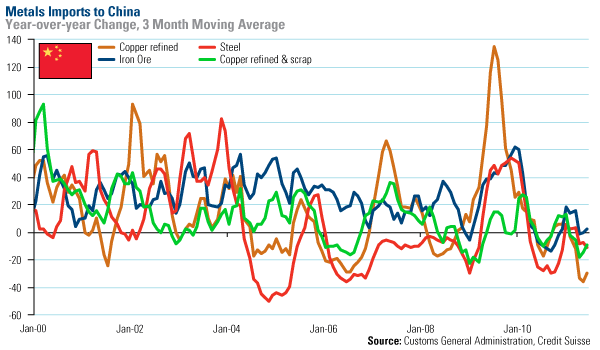
Imports of major metals to China are already running low, says Credit Suisse. While the year-over-year change in iron ore imports is at the same level as last year, copper imports are at an 11-year low, based on its year-over-year percent change.
So, if you’re counting the market’s cards, you can see that nearly all of the bear market’s aces have been played. Now that China’s PMI has turned upward, along with the potential for China’s monetary policy easing, it’s possible we’ll see a run in commodities through Chinese New Year.
From the article entitled, “Do Bullish Investors Have an Ace in the Hole?” by Frank Holmes. Frank Holmes is chief executive officer of U.S. Global Investors – a registered investment adviser that manages approximately $2.8 billion. The information provided herein has been provided to MiningFeeds.com by the author and, as such, is subject to our disclaimer: CLICK HERE.

The evidence is mounting that the commodity markets will get back to “normal” after the sovereign debt crisis is resolved and growth from China, India, Africa and other developing nations is confirmed.
Gus Gunn, of the British Geological Survey, has identified three main factors behind the steep rise in commodities demand this decade:
- Urbanization that is accompanied by a rise in the standard of living;
- Population increase; and,
- Development of new technologies whose components and gadgets are based on an ever broader base of elements.
By 2025, nearly 2.5 billion Asians will live in cities, accounting for almost 54 percent of the world’s urban population. India and China alone will account for more than 62 percent of Asian urban population growth and 40 percent of global urban population growth from 2005 to 2025.
There is no shortage of individual reasons why some argue that the price of commodities will continue to rise, but when taken together the evidence starts to be overwhelming:
- Finite raw materials;
- Unstable weather patterns;
- Chronic supply constraints;
- Increasing population base;
- Growing global middle class;
- Low real interest rates;
- Shifting global trade patterns;
- Continued monetization of European and US debt;
- Persistent Dollar and Euro feebleness – our political masters attempting to devalue our way to prosperity;
- The need for asset diversification; and
- Speculation.
Will all of these reasons, working together, translate into higher commodity prices? Have today’s worries only temporarily unseated a commodities supercycle? Is the recent sell-off nothing more than a short downturn within a secular bull market for commodities?
Since the financial crisis of 2008, resource companies have:
- Cut their debt;
- Built up their cash reserves to considerable levels; and,
- Are generating solid cash flow.
Based on actual earnings resource stocks are priced where they were at the bottom in 2008 and mining stocks are selling at single digit price earnings ratios. Bottom line? High quality resource stocks should be on every investor’s radar.
Since hitting $1,900 an ounce through the beginning of October, gold has declined nearly 11 percent. Over the same timeframe, the NYSE Arca Gold Miners Index lost almost 13 percent. That’s a closer performance correlation than the roughly 3-to-1 gold equities to bullion ratio we’ve historically seen and could mean the miners are finally closing the gap.
However, TD Securities Equity Research points out this interesting fact: Over a period of 18 months prior to hitting $1,900, gold rose 79 percent but TD’s basket of gold equities only increased 57 percent. The firm says this performance gap “ranks as the worst relative performance of gold equities to gold since 2001.” During the July through September period of 2008, TD Securities’ universe of gold equities declined 46 percent, while gold bullion only lost 24 percent. In October through November of 2008, the same gold equities lost 37 percent; while gold decreased 22 percent.
What’s behind today’s record disparity?
Part of it may be due to the underperformance of the explorers and developers, which, TD says, “have been hit the hardest.” The chart below shows gold miners by capitalization and their returns since April 2011. Explorers and developers have declined the most, losing 21 percent, small- and mid-cap producers have declined 6 percent and large producers lost 5 percent.
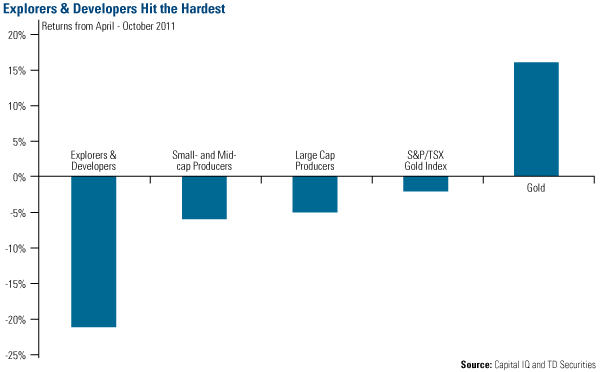
Because of the dramatic price decline in these early-stage companies, investors have the opportunity to purchase explorers & developers (E&D), often referred to as juniors, at about half of the company’s net asset value (NAV). In simplest terms, the NAV means assets minus liabilities. In fact, you can see from the chart that the current price-to-NAV level for E&D equities is sitting near record low levels…levels not seen since the financial crisis of 2008.
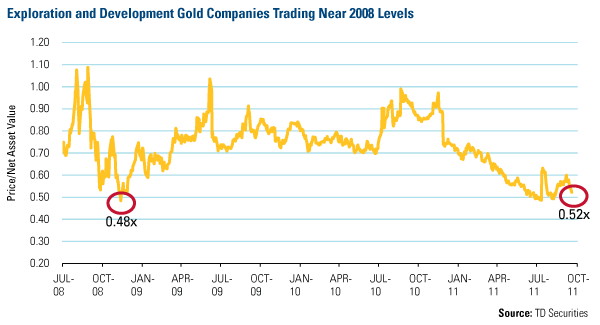
TD found that in seven of the past 10 rallies, gold equities beat gold—averaging a beta of 1.4 times. Looking over the next year or so, we believe the smaller gold miners may be poised to outperform this time. As TD says, “on a rebound, we expect the best performing equities to be among the ranks of the explorers and developers.”
From the article entitled, “Which Gold Miners Have Largest Upside?” by Frank Holmes. Frank Holmes is chief executive officer of U.S. Global Investors – a registered investment adviser that manages approximately $2.8 billion. The information provided herein has been provided to MiningFeeds.com by the author and, as such, is subject to our disclaimer: CLICK HERE.

It was another big week in the markets with positive gains across most of the world’s major exchanges. The TSX and TSX-V were no exception up 4.1% and 3.7% respectively. But we’re not interested in single digit returns, we’re taking a look at the top three mining companies that posted the biggest percentage gains this week on both exchanges.
1. Minco Gold Corp. (TSX: MMM) up 40%
On absolutely no news to speak of, Minco Gold posted this week’s top percentage gain on the TSX for mining companies closing the week at $1.26. Evidently, speculation alone may be sufficient to move the stock. Back on July 7th, 2011, Minco Gold announced the commencement of an initial diamond drill program of the Shajinba zone on its 100-per-cent-owned Yejiaba property, part of the Longnan project, located in Gansu province in China. The drill program consists of 2,000 metres of core drilling, and is designed to test the zone of gold mineralization discovered by the company in 2010. Minco Gold owns 13 million shares (approximately 22.25%) of sister company Minco Silver (TSX: MSV) which, like Minco Gold, was also quiet on the news front this week.
2. Uranerz Energy Corp. (TSX: URZ) up 33.8%
No news is also good news for the TSX mining sector’s second biggest gainer this week. Uranerz Energy is a near-term uranium producer based in Wyoming. The company’s first in-situ recovery mine is under construction and production is projected to start by mid 2012. The company has already entered into long-term uranium sales contracts with two of the largest nuclear utilities in the U.S., including Exelon. So what can we attribute this price move to? Two weeks ago it was announced that, as of Sept. 26, 2011, Robert Disbrow indirectly owns 2.6 million common shares and exercises control or direction over an aggregate 5,186,800 common shares of Uranerz Energy (for a total of 7,786,800 common shares). This equates to approximately 10.1% of the issuer’s issued and outstanding common shares and may have been the catalyst behind the recent upswing.
Robert (“Bob”) Disbrow is a well know Vancouver-based venture capital professional and made his mark on the markets as part of a group of brokers at First Marathon Securities that were under scrutiny from the Cartaway Resources scandal in the mid-1990s. The First Marathon brokers acquired roughly 7 million shares of Cartaway for around $0.10 in 1994 and rose to a high of $26 per share in early 1996. But on May 17, 1996, Cartaway announced that new assay results from its Voisey’s Bay property did not support earlier tests. Heavy trading in Cartaway shares ensued, crashing the Alberta Stock Exchange system. When trading in Cartaway resumed on May 21, the stock opened at $2.78 and ultimately collapsed. In July, 1998, Robert Disbrow, then First Marathon vice-chair and former Vancouver branch manager, agreed to a $110,000 fine and three-month suspension for his role in the Cartaway affair.
3. Champion Minerals Inc. (TSX: CHM) up 32.7%
In what appears to be a delayed response to drill results and a new resource estimate released last week, Champion Minerals was the third biggest mining-mover last week with a gain of just over 30%. Champion Minerals is a Canadian-based iron ore exploration and development company with properties located in Quebec and Labrador. Last week, the company announced drilling results from its Lake Moire property in Labrador which included 503.4 metres grading 31.2% total iron (FeT). Champion also provided a NI-43-101 updated resource estimate on its Fire Lake North project in Fermont, Quebec. The company reported measured and indicated resources total 400.1 million tonnes grading 30.6% total iron and inferred resources total 661.2 million tonnes grading 27.7% total iron. Tom Larsen, Champion’s president and chief executive officer, commented, “The updated resources at Fire Lake North have resulted in a substantial improvement over the initial estimate and far exceeded our expectations. These results will have a major impact on the updated preliminary economic assessment on the Fire Lake North project which is expected to be released next month.”
Not to be outdone, mining companies on the TSX-V Exchange actually posted the biggest gains on the week. We look at the top three widely-traded juniors and take a look at the factors that may have influenced their respective gains.
1. PMI Gold Corp. (TSX-V: PMV) up 87.3%
The stock that posted the biggest overall gain in the week ended October 14th, 2011, was PMI Gold. This move was in direct response to news issued on Thursday in which PMI Gold announced a 270% increase in the NI 43-101 gold resources estimates from its flagship Obotan gold project in Ghana, West Africa, to measured 1.22 million ounces, indicated 2.00 million ounces and inferred 1.29 million ounces. The Obotan gold project was previously operated by Resolute Mining (ASX: RSG) and closed in 2002 after producing a total of 730,000 ounces at an average grade of 2.2 grams per tonne gold when the price of gold was averaging US$350 per ounce. Shares of PMI Gold closed on Friday at $1.03, up $0.45 on the day, on volume of 13.9 million shares.
2. Leven Resources Ltd. (TSX-V: LVN) up 53.4%
Number two this week on the Venture board was North American exploration company Leven Resources. Last week, the company’s shares were trading at $0.88 when the company announced the grant of stock options for the purchase of up to 425,000 common shares at a price of $1.50 per share to directors, employees and consultants of the company. That’s right, $1.50 a share which translated into a 70% premium to the market. Evidently the market may have liked the confident approach of management and the company’s stock rallied this week closing on Friday at $1.35 per share.
3. Coral Gold (TSX-V: CLH) up 48.5%
Last but not least is Coral Gold. Coral posted a 48.5% gain on the week on no news. Perhaps the move might be attributed to a “sell” recommendation from newsletter writer Jay Taylor in late September issued when the stock was trading at $0.49. After the recommendation, the company’s shares traded down sharply to $0.30 on above-average volume but this week rebounded to previous levels closing the week at $0.49.
Coral Gold Resources is exploring a portfolio of claim blocks along the Cortez gold trend in north-central Nevada, collectively known as the Robertson Project. The company’s project is near Barrick Gold’s Cortez Mine, a low cost gold mine with reported proven and probable reserves of 13.4 million ounces of gold.
As I have explained in my previous post on the world gold production, the share of major gold producing countries in the world gold production decreases. But what about the relative production from major gold miners?
As shown in the chart below, world gold production has decreased since 2001 (black line). Similarly, the gold production of the thirteen largest gold miners in the world (orange line) has decreased since 2006. This time shift can be explained by the acquisitions that major gold producers have made on many smaller gold producers around the world. Through acquisition they were able to increase their production temporarly but this does not change the fact that, overall, their respective world gold production is decreasing.
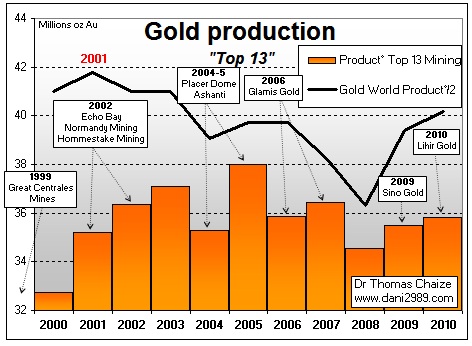
Here are some of the main takeovers of gold producers since 1999: Great Central Mining, Echo Bay (Canada), Normandy (Australia), Hommestake (oldest gold mine in the United States which survived the great depression in 1929), Placer Dome (Canada, founded in the early 19th century), Ashanti (South Africa, producing gold since 1897), Glamis Gold (Canada), Sino Gold (Australia), and Lihir Gold (Australia).
Despite these major takeovers, accounting for tens of billions of dollars, the relative production from major gold producers around the world has declined since 2008. It decreased from 47% in 2007 to 44.5% in 2010. The increase in the world gold production observed since 2008 is the result of smaller gold mines going into production (gold miners producing less than 500,000 ounces of gold per year).
In summary, the growth of world gold production since 2008 arises from a mosaic of small producers. This “atomization” of world gold production into less rational small production requires a high gold price. Smaller producer countries and smaller gold miners have stabilized world gold production in the short term (1-3 years). However, this is not enough to revive global production which is still below its level of 2001 despite the rise in gold prices over the past 10 years.
The takeover of the largest gold mine in the world by a major copper producer in Zambia is symptomatic of the situation of the major gold miners. The large scale gold deposits are increasingly rare and large gold miners are “forced” to produce more and more copper, zinc, lead, silver, molybdenum or uranium.
From the article entitled, “Gold Production of Large Gold Miners” by Dr. Thomas Chaize author of the Mining and Energy Newsletter. The information provided herein has been provided to MiningFeeds.com by the author and, as such, is subject to our disclaimer: CLICK HERE.
U.S. stock markets suffered through the worst quarter since 2008, with the S&P 500 Index dropping nearly 14 percent for the quarter; more than half of this drop occurred in September alone. Only 54 companies in the S&P 500 saw positive returns during the month, while more than 200 dropped at least 20 percent, TheStreet.com reports.
This week, we’d like to point out three reasons investors should consider remaining in equities or reassessing whether to sit on the sidelines: 1. Investor sentiment is signaling the market is overextended to the downside 2. Stocks are trading well below historical valuation trends 3. S&P 500 dividend yields are higher than the 10-year Treasury yield.
1) Investor Sentiment at Panic Level. Citigroup’s Panic/Euphoria model, a proprietary combination of nine facets of investor beliefs and fund managers’ actions, has been in “panic” territory since mid-August. Historically, overly bullish territory (Euphoria) generally signals a market correction is on the way, while a recovery arrives when sentiment is overly pessimistic (Panic). The current panic level “generates a near 90 percent chance of higher equity prices in six months and a 97 percent probability of teen-like gains in the next 12 months,” says Citigroup.
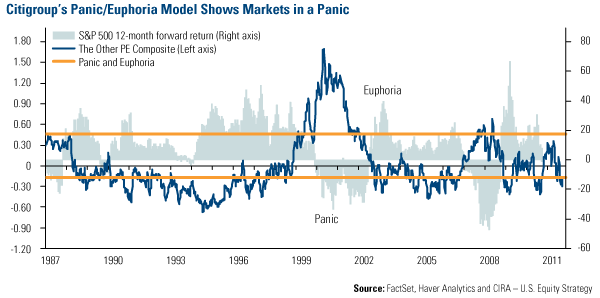
Historically, the average market bounce is 8.9 percent the following six months and 17.3 percent the following year after falling below the panic line. It’s worth pointing out that gauging investor sentiment isn’t an exact science. Markets reached a panic at the end of June and a rebound never came to fruition. However, Citigroup says it does send a “fairly clear contrarian message of opportunity.”
2) Equities Appear to Be Underpriced. One positive result of the selloff is that many equities now appear to be priced at attractive levels. When a stock trades at fair value, that means the equity is “fairly” priced based on a discounted cash flow (DCF) model. DCF uses future cash flow projections a company may earn and then discounts the projections based on the cost of capital. To put it plainly, the DCF is what the company is expected to earn subtracted by what it will cost to generate those earnings, plus the time value of money (TVM). TVM means that money is worth more today than in the future. This chart plots the fair value of the roughly 1,300 U.S.-listed stocks covered by Morningstar. A ratio of one means a company is equal to its fair value. Today’s ratio is 0.81 and is approaching the lows we saw during the worst of the financial crisis in 2008. The current ratio implies roughly 20 percent upside to current equity prices.
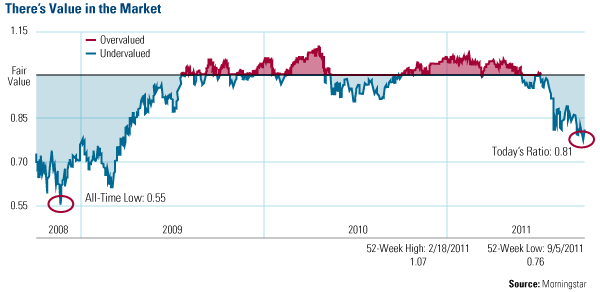
This doesn’t mean equity prices have bottomed, but even pessimistic investors can see that many companies are trading at deep discounts relative to their expected cash flows. BCA Research looked at equity valuations from another angle. The firm analyzed the trailing price-to-earnings (P/E) ratio of the S&P 500 versus the current yield on a 10-year Treasury bill over the past 50 years. Historically, there is an inverse relationship between the two, BCA says, meaning that higher yields on a 10-year Treasury meant lower P/E ratios for equities. This makes sense, because when investors can receive a substantial return from a “safer” government note, there is less incentive to buy equities that may carry a greater amount of risk and vice versa.
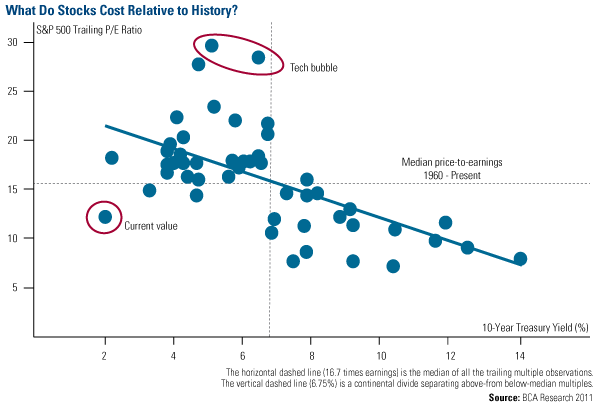
You can see from these plot points that today’s relationship between P/E multiples and yields is a “clear outlier” to historical trends. The other rare instance where values ventured so far from the trendline was during the Tech bubble (when equities were overvalued), but that is the exact opposite than what we have today. BCA Research assesses the market this way: “The multiple-rates analysis highlights that stocks are cheap. However, we do not rule out the possibility that they can get cheaper. Bottom line: If, consistent with our base-case expectation, the U.S. averts a recession, equities are inexpensive enough to provide investors with an attractive risk-reward profile.”
3) Dividend Yields Appear Attractive. Another “buy signal” for stocks we’ve highlighted many times in the past, and now discussed by J.P. Morgan last week, is that investors can receive a higher yield from stocks in the S&P 500 than from a 10-year Treasury. The current dividend yield for the S&P 500 is currently 0.67 percent higher than that of a 10-year Treasury, implying investors could receive a higher return with stocks just by receiving the dividend.
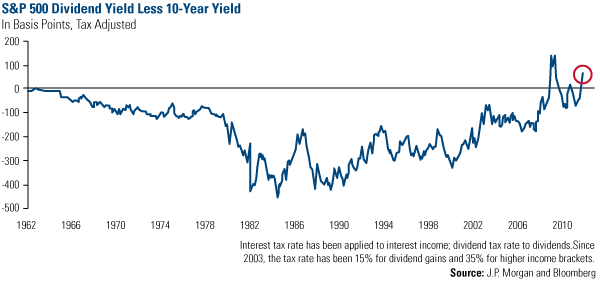
Only Fools Rush In as Elvis sang so many years ago, “Wise men say, only fools rush in.” Now may not be the time for investors to be brave and overload themselves with unnecessary risk. The eurozone continues to struggle to find a way out of the debt mess created by Greece and others, and unemployment in the U.S. stubbornly remains above 9 percent, causing the economy to sputter. Both of these risks could torpedo an economic recovery before it leaves the harbor. The King’s expression also applies to those investors hiding their cash under their mattresses. Investors must evaluate their individual financial situations to balance risk and uncertainty with opportunity, while keeping their focus on the long term. That’s no easy task but strategies such as dollar-cost averaging can at least get them back on the road again. No one knows what tomorrow will bring, but varied indicators are signaling now is the time to be contrarian and take advantage of the opportunity the recent selloff has given long-term investors.
From the article entitled, “Can Markets Find the Road Back to Positive Territory?” by Frank Holmes. Frank Holmes is chief executive officer of U.S. Global Investors – a registered investment adviser that manages approximately $2.8 billion. The information provided herein has been provided to MiningFeeds.com by the author and, as such, is subject to our disclaimer: CLICK HERE.

Thermal coal, which is the cheapest and most common type of coal, is burned to generate steam that powers turbines and produces electricity for either public grids or for large-scale industrial use. Metallurgical coal, on the other hand, is used as a fuel and as a reducing agent (coke) for smelting iron ore in a blast furnace; as such, it is also often referred to as coking coal or steelmaking coal. Metallurgical coal needs to be low in sulphur and phosphorus so these elements do not migrate to the metal during steel making.
Coal is mined in over 100 countries, and on all continents except for Antarctica. The largest reserves are found in the USA, Russia, China, India and Australia. The world’s largest coal producers are China (48%) and the United States (15%) and almost all production is used for domestic needs. On the export side, Australia (26%) is the largest exporter of coal followed by Indonesia (24%). But Indonesia may not be a reliable source of inexpensive coal. Power projects that had planned to get coal from Indonesia are yet to find a solution to a new law that may effectively increase the cost of Indonesian coal. The new regulation says coal sold from the country is to be indexed to the international price and revised annually.
After the earthquake in Japan, some investors are looking towards coal to “pick-up the slack” associated with the possibility of decreased energy output caused by the reduction of nuclear energy programs around the world. But some think this is simply a temporary blip on the energy radar as many countries will reinstate nuclear power as key energy source once the public’s concern subsides.
MiningFeeds.com
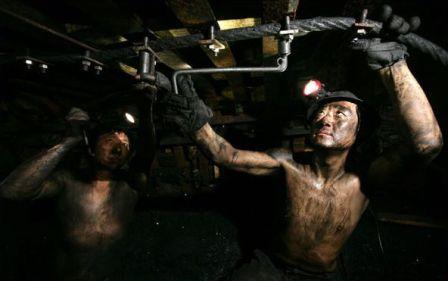
China’s seemingly insatiable demand for raw materials has fuelled a bull market in commodities since 2001. And coal, has literally fuelled the fires of industrial development in China. The coal industry in China is, by far, the largest in the world. But did you know it is also the most deadly? The Chinese coal industry is the most dangerous in the world for deaths resulting from accidents and disease. Mr. Tang, a Representative of Pingding Mountain Coal Miners’ Rights in Henan, noted, “The majority of local coal mine workers (at Pingding Mountain) suffer from pneumoconiosis. My friends and relatives have all contracted this illness. Many have suddenly died from this illness due to lack of air.” There are over 100,000 coal miners working at Pingding Mountain alone. Pingding Mountain is located in the province of Shanix which produces about 25 percent of China’s annual coal requirements.
Many countries in the Asia Pacific region, including China, are major buyers of coal. From an industry perspective this is important because freight charges make up a considerable percentage of the cost of imported coal. On a global scale, China is a low cost producer when compared to other major coal-producing countries. Coal production costs are low in China because labour costs are low. Labour only accounts for about 20 percent of the total production costs of Chinese coal mines, whereas in more developed countries, labour sometimes constitutes as much as 60 percent of production costs. With China at the heart of the international coal industry we begin our watch list with a company that looks to supply Chinese demand from neighbouring Mongolia.
1. Prophecy Coal Corp. (TSX-V:PCY)
It has been a very eventful year for Prophecy Coal. A $42 million public financing, the spin-off of sister company Prophecy Platinum (TSX-V: NKL) and now the challenge of managing growth in the face of volatile markets. Lately, the markets have had a major impact on the company’s share price. Prophecy is currently trading at $0.44 per share which yields a market cap of roughly $90 million. Currently, with $64 million in shares of Prophecy Platinum, $40 million in property and equipment; and a little less that $10 million in cash on the books (as at June 30th, 2011), you are getting the company’s Mongolian coal assets and Canadian mineral properties for, well, less than free.
In July, 2011 Prophecy Coal announced a defensive plan to give the company’s shareholders and directors time to consider alternatives should a hostile takeover attempt emerge. This was primarily in response to the released of a new resource estimate by Prophecy Platinum for its Wellgreen property in Yukon. Shares of Prophecy Platinum surged after the news from $0.60 to $6.00 per share and subsequently greatly increased the asset value of Prophecy Coal. Prophecy Platinum is currently trading at $2.82.
Prophecy Coal reports more than 1.4 billion tonnes of thermal coal on two properties in Mongolia and began selling coal to Russian and Mongolian buyers this year. Situated next to China, the world’s largest coal consumer, Prophecy’s President & CEO, John Lee, thinks Prophecy is well positioned to take advantage of China’s ever-growing energy requirements. We sat down with Mr. Lee to discuss the company’s eventful year and to find out what is on the horizon in 2012 – CLICK HERE – for the interview.
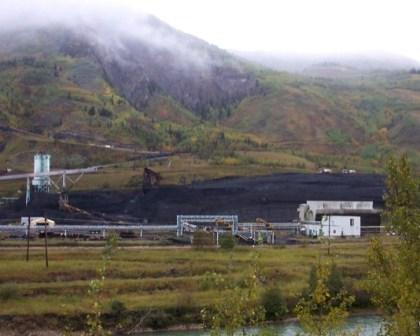
2. Grande Cache Coal Corp. (TSX:GCE)
Mining coal is only part of the equation. Once coal is mined from open pit and underground operations at Grande Cache Coal’s Smokey River Coalfield in Alberta it needs to be processed into “clean coal” for steelmaking. Heavy media cyclones are used to clean the raw coarse coal and flotation is used to wash the fine raw coal.
After the coal is washed the raw coarse coal is separated into clean coal and rejects. The drained coarse clean coal is dewatered in centrifuges and discharged to a separate conveyor. The drained coarse reject material is conveyed to a discard bin and removed by truck to the company’s disposal facility. The fine raw coal is separated into clean coal and fine refuse in a bank of flotation cells. The clean coal froth is passed to a vacuum disc filters for dewatering. The filter cake is then discharged from the disc filters and combined with the clean coarse coal on the clean coal conveyor for transport to the thermal dryer, where the coal is dried.
The thermal dryer, located in a separate building, is fuelled with natural gas. Dried clean coal from the dryer is then conveyed to a clean coal stockpile where it is readied for rail transport to the Westshore Terminals in Vancouver for export. Agreeably, the entire process is somewhat “dry”. Regardless, in fiscal 2011, the company produced about 1.55 million tonnes of clean coal.
Year over year Grande Cache Coal has struggled in 2011. Production was down slightly and the company recently cut its production targets for 2012. While fiscal first-quarter earnings released in August were well below the street’s expectations as costs increased. But with increased production still expected for 2012, Canaccord Genuity analyst Gary Lampard sees diluted earnings per share improving significantly in the second quarter and maintained a “buy” rating (although he cut his target by $0.50 to $11.25). Shares of Grande Cache Coal are currently trading at year lows and can now be had for $3.52.
For 5 Coal Stocks to Watch – Part 2 – CLICK HERE.
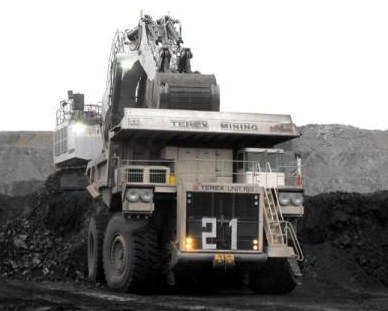
3. SouthGobi Resources Ltd. (TSX:SGQ)
SouthGobi Resources is focused on exploration and development of metallurgical and thermal coal deposits in Mongolia’s South Gobi Region. The company’s flagship coal mine, Ovoot Tolgoi, is producing and selling coal to customers in China. Ovoot Tolgoi is located in southern Mongolia, approximately 40 kilometres north of the Chinese border. Ivanhoe Mines is SouthGobi Resources’ largest shareholder and owns approximately 57% of the issued and outstanding shares of the company.
In August, SouthGobi Resources set a new monthly record of 441,665 tonnes of coal shipped which was a substantial increase over shipping levels from a year earlier. On an annualized basis, the company is producing at 5.3 million tonnes of coal per year and is on track to meet its production targets for the upcoming quarter.
SouthGobi, along with its major shareholder Ivanhoe Mines, have paved the way for business in Mongolia. And although the process hasn’t always been easy, the Mongolian government is proactive and pro-business. Prime Minister Sukhbaatar Batbold, age 48, has worked hard to open the doors to foreign investment. The country is only 20 years removed from the days of Soviet control and is sorting out its path towards a healthy free market economy which includes the world’s smallest stock exchange (Mongolian Stock Exchange). Established in 1991, stock exchange officials hoped the exchange would help to privatize the majority of state assets. Fast forward to 2010, the MSE reported 336 listed companies with a combined market capitalization of roughly $1 billion. SouthGobi Resources has openly expressed interest in listing on the diminutive exchange to validate the direct benefits associated with foreign ownership in Mongolia. MiningFeeds.com connected with SouthGobi’s President & CEO Alexander Molyneux to learn more about the company’s plans – CLICK HERE – for the exclusive interview.
4. Teck Resources Ltd. (TSX:TCK.B)
Teck is the largest producer of steelmaking coal in North America and the world’s second largest exporter of seaborne steelmaking coal. With five mines in British Columbia and one in Alberta, coal is a proclaimed cornerstone of Teck’s diversified mining business. The majority, approximately 90%, of Teck’s coal is exported for steel production. Shipped by rail to the coast of British Columbia the coal is exported to Asia, Europe and South America. The company’s largest markets in Asia have traditionally been Japan, Korea and Taiwan, but the company expects that China will emerge as a significant importer of steelmaking coal as it continues its process of urbanization. Coal accounted for approximately 59% of Tech’s gross profits before depreciation and amortization for the three month period ending June 30th, 2011.
The global sell-off in commodities has spark outright fear in the equity markets over the past few weeks. The declining prices of base metals, crude oil and coal have resulted in some questioning whether we are perhaps heading into another global recession. In its latest quarterly Global Economic Outlook, Fitch Ratings revised down its growth forecasts for all major advanced economies. Maria Malas-Mroueh, Director in Fitch’s Sovereign team stated, “Fitch does not project a ‘double-dip’ in its baseline global economic projections. However, the likelihood of a recession has increased, as intensified financial market volatility could further amplify risk aversion behaviour and lead to tighter credit conditions.”
And in a recent poll released by Bloomberg, most global investors predict Chinese growth will slow to less than half the current pace by 2016. China’s gross domestic product rose 9.5 percent last quarter. Unfettered by negative headlines, last Wednesday Teck’s board approved a $475 million spending program to modernize its four-decade-old copper mill at Highland Valley and earmarked another $210 million for their Trail lead and zinc smelting and refining facility. “We still see strong demand for our products, particular our steel-making coal and our copper,” stated Teck spokeswoman Marcia Smith. Teck confirmed the company is in the best financial shape it’s ever been in contrast to the heavy debt it carried into the financial crisis of 2008. Shares of Teck Resources closed today at a yearly low of $28.69, down over $2.20 on the day, marking a healthy decline of 7.2%.
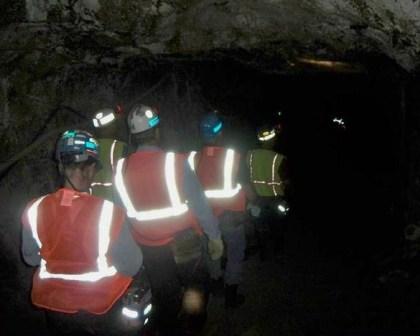
5. Cline Mining Corp. (TSX:CMK)
On August 9, 2011, Cline Mining welcomed the first commercial metallurgical coal shipment into rail cars from the bulk rail load-out facility at its New Elk mine. The company continues to ramp up metallurgical coal production at its flagship mine in southern Colorado with the plan to reach an initial level of production totaling 3 million tons annually by the first quarter 2012.
Cline is also developing its Lossan and Lodgepole metallurgical coal mine projects in British Columbia; the Cline Lake gold property Ontario, Canada; and its iron ore properties Bekisopa, Madagascar. As such, the company’s plate is pretty full. To support this junior miner, Cline has entered into a strategic corporate partnership with Mitsui Matsushima, a Japanese coal miner and conglomerate. Mitsui Matsushima is also a shareholder and, as reported by the company, is represented on Cline’s board of directors.
To complete the development of the New Elk coal mine which includes reinstalling the steel rail spur and financing working capital, Cline completed a prospectus offering of 31,372,000 common shares at a price of $2.75 per common share for total gross proceeds of $86,273,000 in June, 2011. Shortly after the offering the stock began to sell-off. Well know Canadian money manager Frank Mersch said Cline Mining was being “unduly punished” in the market downturn as reported by the Globe and Mail. At the time, Cline’s shares were trading at $2.40 and, about the company, Mr. Mersch said, “We think it could be a double.” Unfortunately for Cline Mining shareholders, Mr. Mersch would have been right if hedged his bet in the other direction. Since Mersch’s prediction the company’s shares are down more than 50% and are currently trading for $1.10 on the TSX Exchange.
For 5 Coal Stocks to Watch – Part 1 – CLICK HERE.

It has been a very eventful year for Prophecy Coal. A $42 million public financing, the spin-off of sister company Prophecy Platinum (TSX-V:NKL) and now the challenge of managing growth in the face of volatile markets. Lately, the markets have had a major impact on the company’s share price. Prophecy is currently trading at $0.44 per share which yields a market cap of roughly $90 million. Currently, with $64 million in shares of Prophecy Platinum, $40 million in property and equipment; and a little less that $10 million in cash on the books (as at June 30th, 2011), you are getting the company’s Mongolian coal assets and Canadian mineral properties for, well, less than free.
In July, 2011 Prophecy Coal announced a defensive plan to give the company’s shareholders and directors time to consider alternatives should a hostile takeover attempt emerge. This was primarily in response to the released of a new resource estimate by Prophecy Platinum for its Wellgreen property in Yukon. Shares of Prophecy Platinum surged after the news from $0.60 to $6.00 per share and subsequently greatly increased the asset value of Prophecy Coal. Prophecy Platinum is currently trading at $2.82.
Prophecy Coal reports more than 1.4 billion tonnes of thermal coal on two properties in Mongolia and began selling coal to Russian and Mongolian buyers this year. Situated next to China, the world’s largest coal consumer, Prophecy’s President & CEO, John Lee, thinks Prophecy is well positioned to take advantage of China’s ever-growing energy requirements. We sat down with Mr. Lee to discuss the company’s eventful year and to find out what is on the horizon in 2012.
2011 has been a whirlwind year for Prophecy Coal and included a $42 million public offering and the commencement of mining operations at Ulaan Ovoo. Please talk about the year and some of your additional achievements.
Absolutely, 2011 has been, and continues to be, a very busy and productive year for Prophecy Coal. By mid-year, we had hit a number of important milestones and competed key phases of project plans for both Chandgana and Ulaan Ovoo. By way of example we successfully commissioned a new mining fleet at Ulaan Ovoo (“UO”), we commissioned UO to commercial production and stockpiled over 230,000 tonnes of coal, we obtained Chandgana Tal Mining License and submitted the Chandgana Power Plant Project feasibility with the Mongolia Government, we received official endorsement for the Chandgana Power Plant from the Mongolian Ministry of Natural Resources and Energy; and, we completed the spin-off of Prophecy’s core Canadian assets to Prophecy Platinum. We also strengthened the board and management team with the additions of Jivko Savov, Chuluunbaatar Baz, and Ronnie Van Eeden.
The Chandgana power plant project is advancing and continues to attract interest from international investment banks and other potential investors. The power plant license application is progressing through the proper channels within the Mongolian Energy Regulatory Authority (ERA). The Mongolian government has expressed keen interest in working with Prophecy to address the country’s critical energy shortage. Evonik industries of Germany have been engaged to complete TPP Project Bankable Feasibility Study (BFS) by the end of October, 2011, and a Hong Kong investment bank has been retained to advise on project planning and financing. We are pleased with the advancement to date and are looking forward to continuing to develop the project in concert with the people and government of Mongolia and all stakeholders.
2011 was also a year in which lessons were learned and adjustments made to address some of the areas in which we saw room for improvement. While we invested over $25 million in the equipment and commissioning of Ulaan Ovoo, and were successful in the endeavour it took time to integrate our new staff in Mongolia. Commissioning a new mine and bringing it into production is a significant challenge for any company, particularly so for a new team. Overseeing over 100 Leighton staff consumed considerable resources in addition to the time required to deal with various issues such as late equipment delivery, evolving mine plan, truck availability, local relations, stock piling, and a constrained diesel fuel supply.
Please tell our readers about your coal assets in Mongolia and how do they compare with other thermal coal regions?
In terms of the coal deposit size, Ulaan Ovoo contains 20.7 million tonnes of proven coal reserve, and 208.8 million tonnes of measured & indicated coal resource (NI 43-101; 174 Mt of measured and 34 Mt of Indicated). In terms of quality, the resource contains bituminous (5,040 kcal/kg), low ash (11.3%), low sulphur (0.40%), thermal coal suitable for export. I would also add that the deposit is contained within a single massive coal seam 45-80 m thick with a very low average strip ratio of 1.8:1.
One can see a significant degree of variance in the quality of coal produced among different thermal coal regions, and even within. The tonnage pricing generally reflects the degree of difference. Where demand is concerned, however, attention must also be paid to the logistics of delivery and associated overhead costs. Ulaan Ovoo will feed a domestic market and is situated proximate to the secondary Russian market. Securing year-round access to the Zeltura border crossing just 7km from the mine as well as improved rail access into Russia and to the eastern seaport, will make exports from Ulaan Ovoo that much more attractive to foreign consumers. We are also considering the possibility of building a power plant at Ulaan Ovoo.
With respect to the Chandgana, the deposit is far larger, but with a somewhat lower calorific value. Rather than have an isolated focus strictly upon the nature of the resource, however, one has to consider the ultimate goal of that project. The intent is not to export the resource and incur the associated expenses. Instead, the resource will be consumed on-site, supplying power to the people of Mongolia. There is enough coal at Chandgana to feed a 600MW power plant for decades. Prophecy will then look to ramp up the capacity of the power plant to 4200MW, at which point electricity – rather than thermal coal – will be exported to neighbouring China, in order to alleviate their energy deficit concerns.
Mongolia has been, at times, a challenging place for companies to do business. What have been your experiences with the government and people of Mongolia?
Prophecy has enjoyed a close relationship with both the people and government of Mongolia. They have made it very clear from the beginning that they understand and appreciate that we are focused on moving their country closer to complete energy independence. Our situation does differ in some fundamental ways from those that have been in the news of late. We are confident those situations will get worked out in a way that satisfies all parties concerned. But in the case of Prophecy, the resources extracted – or, in the case of the Chandgana Power Plant, the energy generated – are overwhelmingly destined for consumption by, and for, the people of Mongolia.
Rather than simply a partnership, Prophecy has a relationship with Mongolia. In addition to releasing the country from their dependence on imports from Russia and the economic and political benefits of that alone, Prophecy projects will provide decades worth of employment, facilitate further development, foreign and domestic investment, raise living standards, lower pollution and, longer term, we anticipate generating significant revenues through power exports to supply China’s ever-growing demand. The political and sovereignty concerns that may exist in other current scenarios do not come into play in the case of Prophecy Coal. The benefits of our projects will be overwhelmingly experienced by the people of Mongolia, just as the financial rewards will remain largely within that country.
There are, of course, some speed bumps along the way when embarking on large scale projects in countries like Mongolia. But one has to keep in mind that their government is not a monolithic entity under which power is centralized to the point of being wielded by one or a few. There are some 70 members of parliament in Mongolia, each representing the citizens and groups in their respective constituency. There is always some degree of challenge when working with newer markets, but we are confident the situation will only get better as Mongolia’s fledgling democracy hits its stride and really starts to see the benefits of a full embrace of free market principles and practice.
It is also worth noting, that ours are infrastructure projects built by Prophecy on Prophecy-owned land through capital raised by Prophecy. We see ourselves working and negotiating with the Mongolian Government for the benefit of all Mongolian citizens.
I really want to emphasize the point that we are facilitating and supporting Mongolia’s ongoing expansion and moves toward greater self-reliance and both the people and government have been completely supportive of our efforts in that regard. We have no reason to expect or be concerned with experiencing any substantial challenges moving forward and, quite the contrary, expect them to improve markedly.
You last news release stated that Prophecy’s cash position and equity holdings total over $90-million (U.S.) as of Sept. 1, 2011, how do you plan on putting the capital to work?
Apart from day to day operations, we have no major expenses on the immediate horizon. Once we get the Chandgana power plant license, which, we expect will be awarded before the end of 2011, we will be directing capital to the construction of the physical plant and infrastructure. We have been in discussions with major investors from around the world as well as looking to shortlist EPC contractors so we will be in a position to move forward expeditiously. We anticipate construction cost to be upwards of $800 million. We are considering various options of financing the Chandgana project and it will likely be a combination of different types of financing. We prefer to have minimal dilution, thus, only part of the financing will be equity based.
The recent market meltdown has actually not impacted the price of thermal coal to any large degree. What is your take on the price of thermal coal going forward?
We are confident that the price of thermal coal will rise as we move forward and possibly as high as the $180 USD/t range. There are a lot of factors at play, particularly in terms of simple supply and demand influences. For example, we expect continued growth in China in spite of the economic turmoil in Europe and the United States and the effect this may have on the global economy. While it may not be in a straight line, GDP growth in China should see a sustained increase of 8-10% per year. And, of course, power will be needed to fuel that growth. The fact that the Chinese have been buying coal all the way from Columbia is a clear indication that demand is extremely high.
Exacerbating their energy supply deficit, is the fact that the Chinese have slowed both the output of existing nuclear power plants and the construction of new ones following the recent incident in Japan. We anticipate higher coal demand coming from Japan, as well. Just as it is expected that demand for zinc and other commodities will rise, Japan will need new energy sources to fuel its reconstruction efforts and to compensate for reduced supply in the wake of the recent nuclear crisis.
We are also interested in supply from Australia, given recent developments in the political arena. A rather comprehensive carbon tax has been proposed which the ACA has stated could cost that industry nearly $18 billion over the next ten years. There has also been some concern with the degree to which foreign investment has increased their stake in Australian mining concerns, particularly Chinese stake in coal production. Whether this potential hot button issue will negatively affect exports to any significant degree remains to be seen, however, it is something to keep an eye on. Then, of course, there are the usual weather pattern disruptions, and rising shipping costs to consider.
Globally, we expect that energy demand will increase. We also anticipate oil prices to rise and this should push the price of coal significantly higher as nations look to minimize their energy expenditures and reduce reliance on OPEC. This is particularly true with respect to Asia, where a sustained rise in demand will support higher thermal coal prices, going forward.
One final point worth mentioning here is that coal, particularly outside the Western world, is gaining ever more acceptance by the public. This is due, in large part, to innovative, new clean coal technology that has dramatically reduced emissions as well as stringent environmental standards governing the construction, operation and efficiency of mines and power plants. This is a key factor for the Chandgana project, as we plan to construct a state of the art power plant that utilizes the most advanced clean coal technology available today.
What are your key milestones for 2012 and how might they impact the company going forward?
2012 is going to a busy year at Prophecy, as our Chandgana power plant project will have progressed from the exploration phase, through administration and licensing – along with initial mine development – and into the financing stage. We are expecting the Bankable Feasibility Study commissioned through Evonik, will be complete and ready by q4 2011 at which point we can look to finalize a Power Purchase Agreement and financing arrangements.
Our goal is to secure all necessary financing in 2012, in order to commence power plant construction in 2013. Clearly, this will also involve a great deal of advance planning as well and we will be very proactive in that regard.
It is also important to note that Prophecy Coal holds roughly a 42% share (22.5 million shares) of Prophecy Platinum (TSX.V: NKL), and the two companies are closely affiliated. 2011 has been a very important year in the development of NKL and, in particular, the company’s flagship Wellgreen property – a nickel PGM property in the Yukon Territory. We came out with a new resource estimate that sent shares sharply upwards and undertook a drilling program which yielded impressive results to date. We have engaged Wardrop Tetra Tech to start a Preliminary Economic Assessment on the Wellgreen project as well as SGS Canada to perform metallurgical tests.
We are very optimistic about the future of both companies and are excited about what we will see in 2012 as we continue to make efforts to maximize the potential of all Prophecy projects.
This interview is featured in the article 5 Coal Stocks to Watch – Part 1 – CLICK HERE to read more.
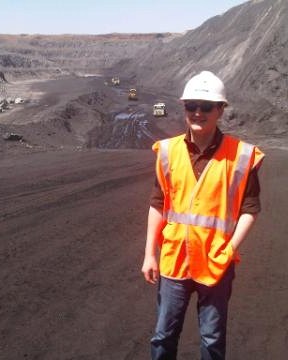
SouthGobi Resources is focused on exploration and development of metallurgical and thermal coal deposits in Mongolia’s South Gobi Region. The company’s flagship coal mine, Ovoot Tolgoi, is producing and selling coal to customers in China. Ovoot Tolgoi is located in southern Mongolia, approximately 40 kilometres north of the Chinese border. Ivanhoe Mines is SouthGobi Resources’ largest shareholder and owns approximately 57% of the issued and outstanding shares of the company.
In August, SouthGobi Resources set a new monthly record of 441,665 tonnes of coal shipped which was a substantial increase over shipping levels from a year earlier. On an annualized basis, the company is producing at 5.3 million tonnes of coal per year and is on track to meet its production targets for the upcoming quarter.
SouthGobi, along with its major shareholder Ivanhoe Mines, have paved the way for business in Mongolia. And although the process hasn’t always been easy, the Mongolian government is proactive and pro-business. Prime Minister Sukhbaatar Batbold, age 48, has worked hard to open the doors to foreign investment. The country is only 20 years removed from the days of Soviet control and is sorting out its path towards a healthy free market economy which includes the world’s smallest stock exchange (Mongolian Stock Exchange). Established in 1991, stock exchange officials hoped the exchange would help to privatize the majority of state assets. Fast forward to 2010, the MSE reported 336 listed companies with a combined market capitalization of roughly $1 billion. SouthGobi Resources has openly expressed interest in listing on the diminutive exchange to validate the direct benefits associated with foreign ownership in Mongolia. MiningFeeds.com connected with SouthGobi’s President & CEO Alexander Molyneux to learn more about the company’s plans.
For someone looking at investing in a coking coal company for the first time, what are some of the key components to consider from both a company and industry perspective?
From an industry perspective people should recognize coking coal is a “late cycle” commodity from a China perspective. China was broadly self-sufficient until around three years ago. This is much later than for copper or iron ore for example. What this means is that we haven’t yet seen the full impact that China’s demand requirements will have on the market and pricing for coking coal. In a slower growth environment, China will still increase its demand for coking coal by 7-8% per year for the rest of this decade. However, its industry really only has the capability to grow around 3-4% per year and even that growth will be endured through rapidly rising costs and continued safety issues etc. The next point from an industry perspective becomes India. Coking coal for India is much more of an upfront issue. India will meet almost all of its coking coal needs through imports. When I look at the situation, it makes me absolutely adamant that coking coal will outperform the broader commodities sector this decade because China and India will have to triple the internationally traded coking coal market just to meet their own needs.
From a company perspective the key is “location, location, location”. Coking coal is a bulk commodity and so the ability and cost of transportation to the market is much more relevant. In the case of base metals, if it’s 80:20 for geology: location, then coal is 40:60. Now this is what’s driving the emergence of new coking coal producers. The grand claims of Canada and USA becoming big suppliers to China’s coking coal needs just hasn’t come to pass. The publicly listed companies doing business there grandstand about China demand but Mongolia, which is right next door to China, is becoming the key supplier. In the month of August for example, our mine in the South Gobi desert alone sold three times the coking coal to China than all of Canada did! Mongolia is now meeting around 45-50% of China’s coking coal import needs. SouthGobi Resources’ mines are the closest coal resources to China. We are 45 kilometers away from China and less than 50 kilometers off Chinese rail. It’s a huge advantage.
Comparing apples to apples, how does SouthGobi’s direct mining cash costs compare to other coal miners in Mongolia and China?
Before China became a force in the global coking coal market, Mongolia’s coking coal deposits were relatively constrained from an infrastructure perspective. As a result some very low cost resources were never mined, including ours. Our current mine, Ovoot Tolgoi has a life of mine strip ratio of around 4 BCM of waste per tonne of coal. Our direct mining cash costs average around US$20/t… that’s around one third to one quarter of costs in Australia, Canada or China.
What are your production rates as we head towards the end of 2011 and what are your target production rates for the end of 2012?
Our target for the calendar year of 2011 is to sell between 4 and 4.5 million tonnes. We’ve really had very smooth production this year and so our run of mine coal production is now running at around 6 million tonnes annualized right now in line with our ramp-up expectations. We have 13 new 240 tonne haul trucks to commission between now and the end of 2012 plus another Liebherr 996 excavator. We will likely finish 2012 with annualized run of mine production in the region of 8 to 9 million tonnes.
There were some issues with increased sulphur content in some of your coal as reported in November of 2010 and quality control measures were implemented. Have these issues now been fully dealt with?
It wasn’t increased sulphur… it was that the sulphur in product coal from on some higher ash seams was higher than the geological work had suggested. It certainly came as a surprise when we started mining that coal for the first time in 2010. The problem is resolved though. The first step was to ‘mitigate’ the problem. That’s all we could do with the resources we had. We started screening the coal to reduce the ash from 25% to around 18% so then the customers started buying that coal because we improved the value of it in a different way. Since then we’ve raised the price of it by 40% and we sell it every day. The other thing is that our sulphur reduces with depth. That coal is already around 0.15% lower sulphur than last year. We will be processing all our coal from the start of 2012 through a combination of a dry coal handling facility at Ovoot Tolgoi and a wet washing facility that will further treat any coals that remain above 10% ash. Every tonne of coal we sell will very soon be in-spec semi-soft coking coal with low to medium sulphur.
It has been rumoured for quite some time that your majority shareholder Ivanhoe Mines has been looking for a buyer for some (or all) of its stake in SouthGobi. Has this affected your ability to operate the company in any way or is this irrelevant to your ongoing business activities?
My feeling is the rumour may have been over done a bit. Regardless, it doesn’t affect our business. We have our own operations, our own capital and continue to move ahead aggressively with our development.
In short, why should an investor take a serious look at SouthGobi Resources as we head into 2012?
We’re in absolutely the right commodity. We are a first mover in Mongolia and are benefitting from new infrastructure and market development, which is increasing the price of our coal. With our growth and introduction of processing, we have an enormous ability to generate reliable cash flows that’s just not priced into our stock.
This interview is featured in the article 5 Coal Stocks to Watch – Part 2 – CLICK HERE to read more.
If you would like to receive our free newsletter via email, simply enter your email address below & click subscribe.
CONNECT WITH US
Tweets
Tweet with hash tag #miningfeeds or @miningfeeds and your tweets will be displayed across this site.
MOST ACTIVE MINING STOCKS
Daily Gainers
 Lincoln Minerals Limited Lincoln Minerals Limited |
LML.AX | +125.00% |
      |
GCR.AX | +33.33% |
      |
CASA.V | +30.00% |
      |
AHN.AX | +22.22% |
      |
ADD.AX | +22.22% |
      |
AZM.V | +21.98% |
      |
NSE.V | +21.05% |
      |
DYG.V | +18.42% |
      |
AAZ.V | +18.18% |
      |
GLA.AX | +17.65% |

 Follow us on Twitter
Follow us on Twitter Become our facebook fan
Become our facebook fan








